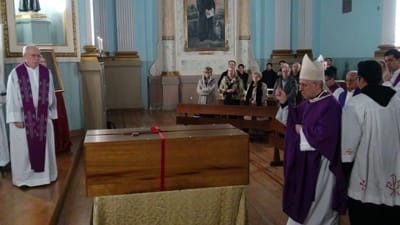On 22nd September 1989, at the age of 89, the Augustinian Recollect Mariano Gazpio Ezcurra died in theNavarraHospital inPamplona, Spain. He was buried in the community’s vault in Marcilla, where he had spent the last 26 years of his life in the monastery.
Very soon, calls in support of his canonization began to be heard. The 1992 General Chapter took the first steps, and in 1998 the Holy See issued its nihil obstat. On 17th January 2000 the cause for the canonization of this former missionary in China was opened. He had dedicated 28 years of enormous efforts to the country from which he had been expelled in 1952. In the years following the opening of the cause, the process went through its initial phases without drawing much attention, until it came to the event which took place in Marcilla this year, on the 29th March.
This event was the exhumation of the remains of the Servant of God, and their translation to the monastery church of the Augustinian Recollects, where they could be more easily venerated both by the friars and by the faithful in general.
The essentials of disinterring the remains had been done in private on the 28th March, in the presence of the Judicial Vicar from the Archiepiscopal Curia inPamplona. The following day was to see their being placed in the monastery church, to which the Augustinian Recollect communities inSpain had been invited.
A huge attendance
The response greatly exceeded expectations, and this was made abundantly clear. At the academic function preceding the Eucharist, the 120 seats in the conference hall of the monastery were quickly filled, and many people had to follow the proceedings either standing inside the hall, or from the neighbouring corridors.
The conference on the life of Mariano Gazpio was the responsibility of Jose Javier Lizarraga, an Augustinian Recollect who from the start had carried out the historical research in his role as vice-postulator. As a result, his address was an official one, but at the same both straightforward and from the heart.
The audience followed it with interest, being left both edified by it, and well-informed.
Following on from this, the central event was the Eucharist, at which Francisco Perez, the Archbishop of Pamplona, presided, together with the Augustinian Recollect Bishop Eusebio Hernandez from the nearby diocese of Tarazona. Some 50 priests concelebrated with them, mostly from the Recollect communities in the north ofSpain. Relatives of the Servant of God filled the church to overflowing, together with Augustinian Recollects in formation, the secular fraternities, and the faithful of Marcilla and neighbouring towns.
Emotion and memory
The coffin, which since the previous day had contained the mortal remains of Fr Gazpio, lay ajar at the foot of the altar. Over and again it was incensed as a sign of veneration, but without being in the spotlight until the final stage of the Mass, this part being under the direction of the postulator for the causes of the saints of the Order, the Augustinian Recollect Samson Silloriquez. The decree of the Sacred Congregation for the Causes of the Saints issued on 26th February 2014 was read out in both Spanish and Latin, authorizing the translation of the remains. The signing of the official documents recognizing and authenticating the remains was the responsibility of the
Archbishop ofPamplona, and these documents were then placed inside the coffin, within which were the remains of Fr Gazpio, in a zinc box. Archbishop Perez closed and sealed the coffin, before it was carried to its final destination, on the left side of the transept, under the painting of Our Lady of Consolation.
This final move was particularly emotional, for amongst those who carried the coffin were the last two survivors of the former mission toChina, the Augustinian Recollects Benito Suen and Melecio Ho. Both of these are very elderly and not in the best of health, but neither wished to lose the opportunity of being present and witnessing to that Church of martyrs, which today is flourishing so much.



